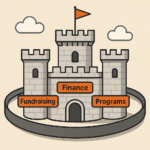Ring-fencing Data by Business Unit

Nonprofits talk a lot about “data integrity” and “single sources of truth,” but in practice, many overlook one of the most critical governance mechanisms: ring-fencing data by business unit. Done well, it ensures security, accountability, and operational clarity. Done poorly—or ignored altogether—it’s a recipe for chaos, mistrust, and costly errors.
Why Ring-fencing Data Matters
- Protecting Confidentiality
Not every staff member needs to see every piece of data. Your major gifts team doesn’t need access to sensitive HR records. Your events team doesn’t need visibility into grant application drafts. Ring-fencing ensures people only see what they need to do their jobs. - Maintaining Compliance
Data protection laws (GDPR, HIPAA, Australia’s Privacy Act, etc.) all demand strict control over personal and financial information. Without clear boundaries, you risk breaches that can trigger penalties and damage your reputation. - Reducing Errors and Duplication
When everyone can edit everything, mistakes multiply. Ring-fencing sets clear ownership: this unit owns these records, that unit owns those records. It builds accountability and cuts down on conflicting updates. - Improving Trust in the System
A CRM is only as valuable as the trust people place in it. When staff know data is properly governed and controlled, they’re far more likely to adopt and rely on the system.
How to Do It Right
- Start with a Data Governance Framework
Define roles, permissions, and responsibilities at the organisational level. Your framework should spell out who owns what data and who has the right to view, edit, or export it. - Map Business Units to Data Sets
Identify the specific data each business unit needs. For example:- Fundraising: donor history, pledges, campaign data
- Finance: payment details, reconciliations
- Programs: service delivery outcomes, client demographics
- Leverage Role-Based Access Controls
Modern CRMs like Salesforce NPSP or Blackbaud’s Raiser’s Edge allow granular control. Use role-based access so that staff permissions match their function—not their seniority or “just in case.” - Use Data Segmentation, Not Silos
Ring-fencing isn’t about building walls. It’s about controlled access within a shared system. Everyone works in the same CRM, but each unit sees the subset that’s relevant to them. That way you get both collaboration and security. - Audit and Review Regularly
Permissions set today may not be right six months from now. Staff change roles, new teams emerge, compliance rules shift. Schedule regular reviews of your access controls and update them proactively. - Educate Staff on Why It Matters
Ring-fencing isn’t just an IT issue—it’s an organisational culture issue. Staff should understand why they don’t have access to “everything” and why that protects the organisation and its mission.
Ring-fencing isn’t bureaucracy—it’s best practice. Nonprofits that get it right protect their stakeholders, maintain compliance, and foster trust in their data. Those that ignore it invite risk, inefficiency, and internal friction.
If your nonprofit is serious about data integrity, start ring-fencing today. Your staff—and your donors—will thank you.
